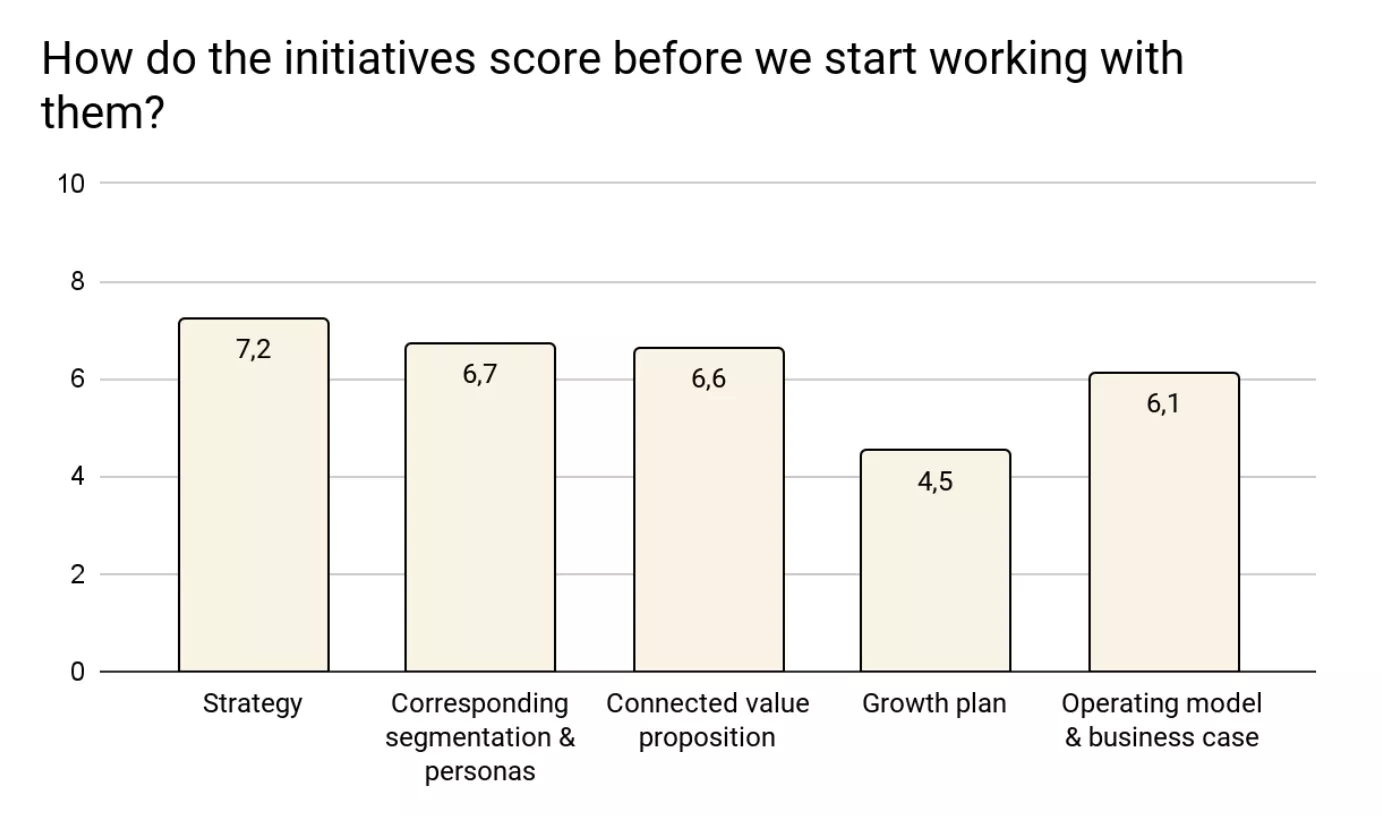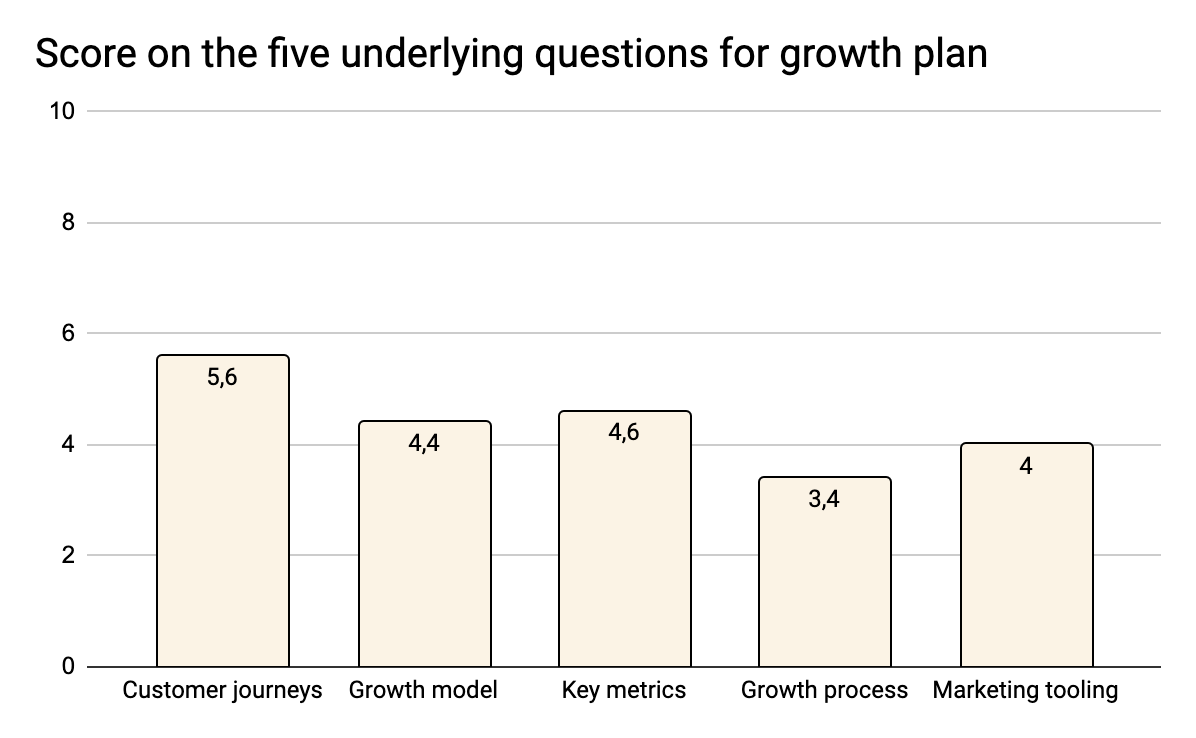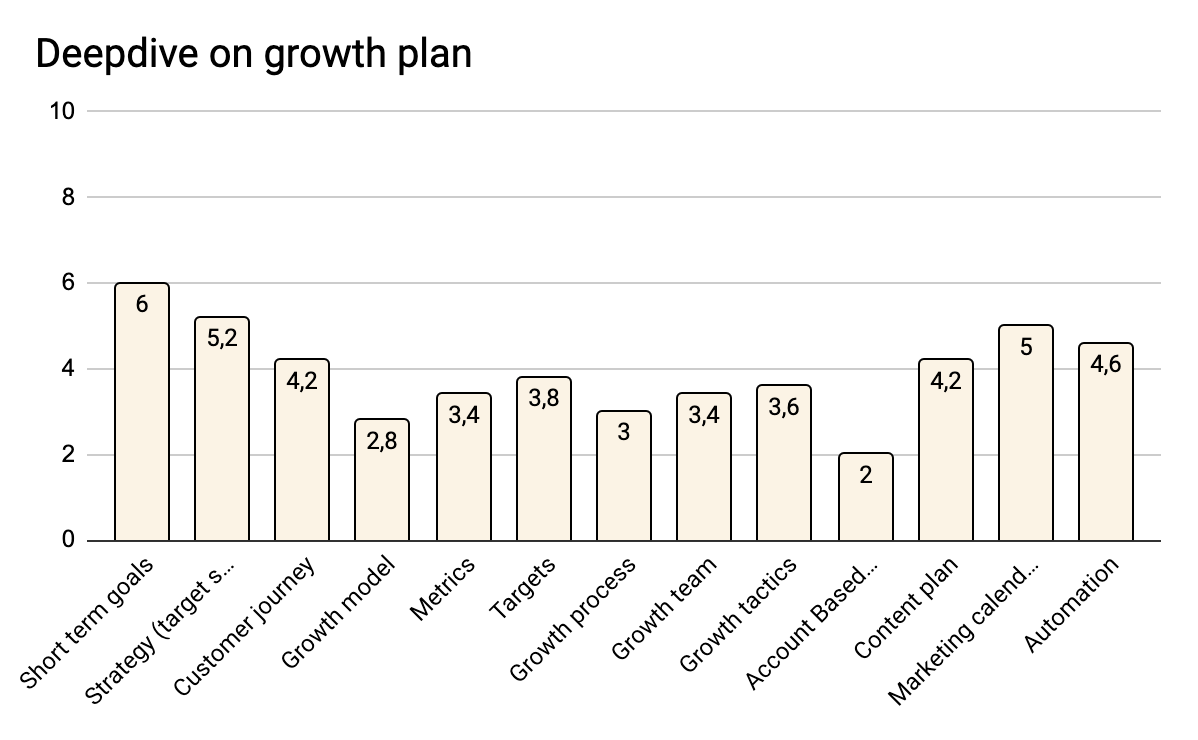Growth is a crucial aspect of any business, and it’s essential to plan it out effectively to drive success.
However, in our experience working with 150 venture builders and studying 120 growth plans, we’ve found that many initiatives struggle with planning their growth efforts.
The initiatives we’ve evaluated are those that consider themselves to have reached product-market fit, have been in business for more than three years, and are considered mature in terms of their team size and MRR.
The good news is that, on average, all initiatives score at least a 6.1 on a scale of 0-10 on our Traction Tracker. However, when it comes to growth plans, the average score was a mere 4.5.

Ave. score of all initiatives on the five axes of Kanagawa’s Traction Tracker
(In 2021-2022, based on >50 ventures assessed.]
This raises the question, how is it possible that initiatives can score well in other areas but struggle with growth planning?
In this blog, we’ll dive deeper into our research results to uncover why most of our clients fail to plan their growth efforts. We’ll also provide actionable steps initiatives can take to succeed in planning and executing their growth efforts.
So how can it happen many initiatives still fail?
Here is what we found from our research…
1. None of the growth essentials were covered
The major issue we found was that none of the growth essentials were covered in most of the growth plans we evaluated. Some of our findings revealed:
- Customer journey definition is scoring a minimum pass, indicating that many initiatives have not fully defined or understood their customer’s journey.
- Many initiatives were not covering all the key elements needed for tracking progress and measuring the success of growth efforts, such as metrics, targets, teams, and processes, making it difficult to track progress and measure the success of growth efforts.
- Many initiatives were not clearly defining their growth model, which is essential for successful execution, making it difficult to plan and execute growth efforts effectively.
- The process and team needed to steer growth is insufficiently present, making it difficult for companies to execute their growth strategy effectively.
- Most initiatives are unable to identify the right marketing tooling stack, which leads to inefficient processes, making it difficult to track progress and measure the success of growth efforts effectively.

Ave. score of all initiatives on growth plan
(In 2021-2022, based on >50 ventures assessed.)
2. Most initiatives barely pass on the execution of their short-term growth plans
One of the key issues we found was that most initiatives barely passed the parameters for short-term growth plan execution. This means that they were not focusing enough on experimentation and testing to validate their growth hypotheses.
Some of our findings revealed;
- None of the initiatives understood or implemented growth modeling: Most of the initiatives we evaluated did not clearly understand how to model and visualize their growth strategy. This is an essential step in planning out growth efforts and can help initiatives identify areas for improvement and track progress.
- Inaccurate definition of their target market, audience segments, and ideal customer personas: Without a clear understanding of who their target audience is, initiatives may struggle to identify their pain points and provide solutions to their product or service. This can lead to ineffective growth efforts.
- Missing/ inaccurate metrics, targets, team, and processes (key pillars of the growth model): Metrics, targets, team, and processes are all crucial components of a growth model. Without clear metrics, targets, and processes in place, organizations may struggle to execute on their growth strategy and track progress.
- Lack of a marketing plan with defined timelines for experiments and activities undertaken: A marketing plan with defined timelines can help organizations stay on track and execute on their growth strategy. Without a plan in place, organizations may struggle to identify areas for improvement and measure the success of their efforts.
- Lack of a marketing calendar (similar to content and social media calendars): A marketing calendar can help initiatives stay organized and plan out their marketing efforts. Without a calendar, initiatives may struggle to execute their growth strategy and track progress.
- Lack of an experiment backlog owing to an inability to execute: Without a backlog of experiments, initiatives may struggle to track progress and identify areas for improvement. This can make it difficult to execute their growth strategy.
- Inability to measure automated growth efforts (no attribution model, wrong data points and performance metrics, scattered data): Without the ability to measure automated growth efforts, initiatives may struggle to understand the impact of their efforts and identify areas for improvement. This can make it difficult to execute their growth strategy.

Ave. score of all initiatives on growth deep dive
(In 2021-2022; based on >50 ventures assessed.)
So what can companies do to improve their growth plans?
To succeed in planning out your growth efforts, there are a few key steps you can take:
1. Identify your target market and ideal customer persona
Identifying your target market and ideal customer persona is essential in planning your growth efforts. By understanding your target audience, their pain points, and how you can solve them with your product or service, you can tailor your marketing efforts and product development to meet their needs better. This can help increase customer engagement and retention, leading to better growth prospects.
To identify your target market and ideal customer persona, you can conduct surveys, customer interviews, and market research to gather data on demographics, behavior, pain points, and preferences.
2. Understand growth modeling
Growth modeling is the process of identifying and analyzing the key drivers that influence a company’s growth. It is crucial for visualizing and executing a growth strategy.
At Kanagawa, we have created a Growth Model Canvas, which is a visual tool to help you model and visualize your growth strategy. By understanding growth modeling and using tools like the Growth Model Canvas, you can identify areas for improvement, track progress, and validate hypotheses.
3. Set goals for your experiments
Setting goals for your growth experiments is an important step in planning out your growth efforts.
By setting measurable goals, you can track progress and measure the success of your growth efforts. It also helps align your growth objectives with the company’s OKRs (Objectives and Key Results) to ensure the growth efforts align with the overall company strategy.
4. Set up a streamlined process for the team
Setting up a streamlined process for the team is important for easy collaboration and alignment. This means creating processes that help everyone stay on the same page and work towards a common goal.
Clear processes ensure everyone is on the same page and working towards the same goals. This can help increase efficiency, reduce confusion, and improve communication.
5. Identify the right skills for the team
Identify the skills required for your growth strategy and build a team with a mix of marketing, product development, data analysis, and customer service skills. Prioritize those with experience in growth marketing and experimentation and a data-driven mindset.
Focus on building a diverse team with a range of skills and backgrounds for new perspectives and ideas. Once identified, hire, develop, and train team members to acquire the necessary skills for your growth strategy.
Benchmark your growth efforts
Planning out growth efforts can be challenging for many organizations, but by following the steps outlined in this blog, you can increase your chances of success.
By identifying your target market and ideal customer persona, understanding growth modeling, setting goals for your experiments, setting up a streamlined process for the team, identifying the right skills for the team, and focusing on building a diverse team, you can execute on your growth strategy and drive better results.
Additionally, it’s important to benchmark your efforts to not only track progress and see how you’re doing compared to other organizations in your industry but also identify areas for improvement.
At Kanagawa, we can help you with this through our Traction Tracker, Growth Modeling, and Execution services. By using these tools, you can measure your progress, validate hypotheses, and make data-driven decisions to optimize your growth efforts.
Ready to score your growth plans?




